October 30, 2009
Air Date: October 30, 2009
FULL SHOW
SEGMENTS
Smart Power to the People
View the page for this story
President Obama just announced 3.4 billion dollars worth of stimulus money to roll out the American smart grid. This new grid will put more control in the hands of consumers, who will be able to use the internet to adjust how and when they use their power. The city of Boulder, Colorado is ahead of the game with a few smart grid homes already up and running. Host Steve Curwood talks with Kara Mertz, the Local Environmental Action Division Manager for Boulder about her city’s smart grid plan. (05:00)
Molten Metals to Green the Grid
/ Jeff YoungView the page for this story
The U.S. government is investing hundreds of millions in high risk, high reward research that could produce what it calls “transformational technology” that changes our energy future. Host Jeff Young visits the lab of a MIT scientist who got support to develop batteries made from molten metals. If it works, it could allow for massive storage of renewable energy for times when there’s not enough sun or wind. (07:00)
Framing the Anything But Climate Debate
View the page for this story
The Senate recently rolled out new legislation to limit greenhouse gas emissions. It’s called The Clean Energy, Jobs and American Power Act and two words are noticeably absent: climate change. Host Steve Curwood speaks with long-time Democratic strategist and linguist George Lakoff about the decision to frame the climate change bill as anything but the climate change bill. (05:30)
From Brownfields to Solar Plains
View the page for this story
In November, the EPA will begin a series of national workshops to open dialog between developers, government leaders and conservation groups about reclaiming brownfield sites for renewable energy. Soji Adelaja, director of the Land Policy Institute at Michigan State University, tells host Jeff Young about the potential to transform brownfields from wastelands into sustainable infrastructures, and why he believes the time is right for these green projects. (05:50)
Perfect Storm for Fish Kill
/ Erica PetersonView the page for this story
A massive fish kill at the 38 mile long Dunkard Creek on the West Virginia – Pennsylvania border has scientists and regulators wondering what went wrong. All signs point to the toxic golden algae but some say it was the polluted creek, with high levels of chloride, which provided ripe conditions for the fish kill. It’s the first time golden algae has appeared in the northern part of the country and, as West Virginia Public Broadcasting’s Erica Peterson reports, there are fears the invasive will spread to other watersheds. (06:40)
New TV Rules in the Golden State
View the page for this story
Flat screen televisions are some of the most energy thirsty appliances in your home. Now, the California Energy Commission is about to set new mandatory energy standards for TVs. Host Jeff young speaks with LA Times reporter Marc Lifsher. (06:00)
Dining with Birds
/ Steve CurwoodView the page for this story
Hugh Wiberg like birds and growing big pumpkins. The author of “Hand-feeding Backyard Birds,” Mr. Wiberg died on October 2nd. In tribute, we re-broadcast a LOE favorite from the year 2000 where he teaches host Steve Curwood the finer points of feeding wild birds out of the palm of one’s hand. (06:30)
Still Life
/ Verlyn KlinkenborgView the page for this story
Sometimes time seems to stand still. But soon enough, as commentator Verlyn Klinkenborg notes, the clock resumes ticking, and the weather changes, marking the change of seasons. (03:00)
Show Credits and Funders
Show Transcript
HOSTS: Steve Curwood, Jeff Young
GUESTS: Kara Mertz, George Lakoff, Soji Adelaja, Marc Lifsher
REPORTERS: Jeff Young, Erica Peterson
CONTRIBUTOR: Verlyn Klinkenborg
[THEME]
CURWOOD: From Public Radio International - this is Living on Earth.
[THEME]
CURWOOD: I’m Steve Curwood.
YOUNG: And I’m Jeff Young. The administration pledges billions to make the electricity grid smart – it could cut our utility bills, slash our greenhouse gas emissions, and prevent power outages.
MERTZ: They have sensors on the transformers that record temperature. So if a transformer is getting hot, the control center can see that and route the power around that transformer before it blows.
YOUNG: Building the smart grid.
CURWOOD: And the quest for a battery big enough to store renewable energy for times when there’s not enough sun or wind.
SADOWAY: It would have enormous capacity. And it would be cheap to build. Storage is critical but the storage has to be scalable, has to be big, not a whole bunch of cell phone batteries strung together like Christmas tree lights.
CURWOOD: Also the sweet sadness of autumn. That – and more - this week on Living on Earth, so stick around!
ANNOUNCER: Support for Living on Earth comes from the National Science Foundation and Stonyfield Farm.
[THEME]
Smart Power to the People
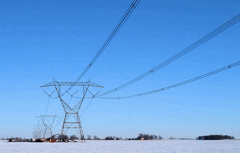
CURWOOD: From the Jennifer and Ted Stanley Studios in Somerville, Massachusetts - this is Living on Earth. I’m Steve Curwood.
YOUNG: And I’m Jeff Young. President Obama has been criss-crossing the country, talking up clean energy at the country’s largest solar power plant in Arcadia, Florida. The President delivered three point four billion dollars worth of grants to update electricity transmission, and create what’s called a smart grid to increase efficiency and promote energy-saving choices for consumers.
OBAMA: We can imagine the day when you'll be able to charge the battery on your plug-in hybrid car at night, because your smart meter reminded you that nighttime electricity is cheapest. In the daytime, when the sun is at its strongest, solar panels like these and electricity stored in car batteries will be able to power the grid with affordable, emission-free energy.
CURWOOD: Boulder, Colorado has already partnered with the utility company Xcel Energy to pioneer the smart grid in homes. Kara Mertz works for the city of Boulder as manager of the project. Uh, Kara, what does a home on the smart grid look like?
MERTZ: It looks like a normal home, but what you see is you see programmable thermostats on the walls, and those programmable thermostats are controlled through a website. So, the homeowner in that house can go online, and they can say, during the hours of two PM to eight PM please turn my thermostat down four degrees, since that is when the power is most expensive. So, you could program the temperature of your home, when your appliances come on and off in that home. So, for example, if you know you work during the day and you don’t need your plasma TV on standby all day long, but you want it to turn on at like four o’clock so when you come home at five you just flip it on and it’s already warmed up, then you can program that through this website, as well.
CURWOOD: Let’s say that I have set up my circuits there so that my dishes get washed in the off-peak hour, but I get a phone call that my mother-in-law is coming over and all those dishes, which would wait until really late tonight, I need to get them washed now; can I just get the dishwasher going?

(http://www.flickr.com/photos/fornal/404093208/)
MERTZ: Actually, yes, and there’s manual overrides for any of the appliances or thermostats, so you don’t actually have to go back on the web if you want to manually override the settings. And there’s some programs that Xcel is going to be piloting here, where you can program this to say I don’t want my electricity bill to be more than $100 a month, so warn me, you know, when I’m at the 75 percent point, and I can adjust my usage so that I know I can depend on a $100 per month electricity bill.
CURWOOD: What is Xcel Energy doing with the information that they’re getting from this process, managing the smart grid?
MERTZ: Some of the things they’re doing is efficiently matching their supply with their demand. The other part of it is to minimize their operational costs by sensing outages before they happen; they have sensors on the transformers that record temperature, so if a transformer is getting hot, the control center can see that and route the power around that transformer before it blows. Whereas, right now, the way that they sense outages is they sit around essentially waiting for someone to call, and a customer calls up and says my electricity is out, and they say thank you very much and they make note in their outage system of your address, and then they sit around and wait for someone else to call. Once, you know, ten or 15 people have called and said, hey my electricity is out, then they can say, hmm, it looks like maybe it’s this transformer over here that’s out because we see the pattern of who’s calling us, we’d better send a truck out. And that’s like a 20 minute or hour long process, whereas now, as soon as that person calls they can look online and say, oh, it looks like all the systems are working to your home, are you sure that your circuit isn’t just blown in your house?
CURWOOD: Kara Mertz, tell me, do you have one of these gizmos in your own house?
MERTZ: I don’t yet. We have a smart meter on our home, but we don’t have any of the advanced, in-home energy management tools yet. I’m hoping for an all electric vehicle that I could then charge from and discharge to back to the grid in 2010.
CURWOOD: Wait a second, your electric car discharge back to the grid?
MERTZ: Yeah. The idea is that if there’s a high enough concentration of electric cars or hybrid electric vehicles that are plugged into the grid, then Xcel can draw power that’s stored in the batteries of those cars in times of peak energy demand. The vision is that each car would have an individual IP address, much like your computer does, and so it wouldn’t matter where you were plugged in Xcel would recognize your vehicle and credit your electricity bill.
CURWOOD: So, even though your pilot project is still in its infancy, what are you hopeful about with the future of the smart grid?
MERTZ: I’m hopeful about the promise of putting power back into the hands of the consumer because, really, electricity is so ethereal to most people, it’s invisible, you kind of don’t know how much it costs on a day-to-day basis or an hour-by-hour basis, and you don’t really know if it’s coal you’re causing to be burned or solar power that you’re drawing from. And, so I think this would allow us all to know our power as individuals and know where it’s coming from.
CURWOOD: Kara Mertz is a project manager for the city of Boulder, Colorado’s smart grid project. Thank you so much.
MERTZ: Thank you so much.
Related links:
- For more information about the smart grid from the U.S. Department of Energy, click here:
- To learn more about Xcel Energy’s plans to make Boulder, Colorado into a smartcity click here:
Molten Metals to Green the Grid
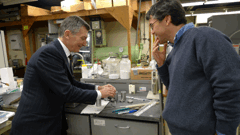
“So much has to be invented,” Sadoway tells Living on Earth’s Jeff Young. “No one’s ever tried this kind of chemistry before.” It’s the kind of pioneering research the Dept. of Energy hopes might pay off with “transformational” technology.
YOUNG: Well, the Obama administration also wants the power that smart grid carries to come from cleaner sources. The Department of Energy just announced the first recipients of 400 million dollars in grants designed to push the boundaries of energy research. The winners are a mix of small technology companies and some of the country’s biggest research universities, like Penn State, Stanford and MIT. I visited MIT in Cambridge, Massachusetts, where President Obama issued this challenge to engineers and scientists.
OBAMA: From China to India, from Japan to Germany, nations everywhere are racing to develop new ways to produce and use energy. The nation that wins this competition will be the nation that leads the global economy. I am convinced of that. And I want America to be that nation. It’s that simple. (Applause.)
YOUNG: But just after this speech, I caught up with MIT president, Susan Hockfield, and asked what she thinks it will take to meet President Obama’s goal.
HOCKFIELD: The problem we face in this country is that it’s been a rollercoaster of support, it goes up when oil prices go up, it goes down when gas prices drop, and with that kind of rollercoaster, the problem is that you always end up at the starting gate. And so, in order to really create and energy revolution, we need sustained – a sustained commitment to energy R and D funding.
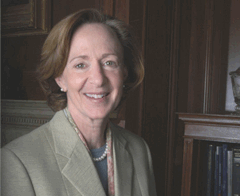
Susan Hockfield is President of MIT
YOUNG: Hockfield’s encouraged by the administration’s new approach to energy research. It’s modeled on the Defense Department’s Advanced Research Projects Agency – DARPA, as it’s known, made long-shot bets in high-risk research, and it gave us things like body armor and the Internet. Three years ago, a National Academy of Science’s paper called for the same kind of program for energy research, an ARPA-E. That paper was written by a Nobel-winning physicist named Stephen Chu.
CHU: If you look at what the United States has, it has unarguably the greatest research and development centers in the world, in our universities, our national labs, and in the private sector. And so, once we get this great innovation machine geared and going, we would be invincible. But, the only trouble is, let’s get it going.
YOUNG: Now, of course, he’s Energy Secretary Stephen Chu, and thanks to money from the Economic Stimulus Act, he’s awarding the first ARPA-E grants. 3,600 scientists applied for the first round, just 37 were approved. The winners included ideas for improving biofuels, others aim to capture carbon dioxide emissions, and some of the winners are looking for breakthroughs in batteries. And that brings us back to MIT:
[SQUEAKING DOOR; MAN SAYING “WE NEED SOME WD-40 ON THAT; VOICES LAUGHING]
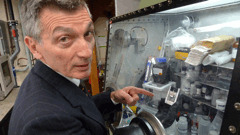
Prof. Sadoway shows a cut-away of one of the small liquid metal batteries after it’s been tested. He can make them work at this size. Now he wants to try to make them big. Really big.
YOUNG: Down in the well-worn basement labs of MIT’s building number eight, Don Sadoway shows me his winning idea for a liquid metal battery. The materials chemistry professor’s been at MIT three decades. Now, the seven million dollar grant will help him scale up his latest project. He slips his hands into the black sleeves of an airless glove box, where some of the batteries – now solid at room temperature – have been cut in half.
SADOWAY: So, here’s – here’s one of them, you can see the upper layer here, there’s liquid metal that’s at the top…
YOUNG: Uh huh.
SADOWAY: This granular stuff is the electrolyte, which is a molten salt, and you can see a second shiny zone at the bottom here, which is the second liquid layer, and it’s self-assembled, self-separated; there’s no divider, no separator here.
YOUNG: So when this heats up, these metals kind of sort themselves out because they’re different densities, is that the deal?
SADOWAY: Exactly, you have two factors here: All three liquids are of different density, okay, and the second thing that’s equally important, they’re remissible just like oil and water because I don’t want to put any separators in here. That’s the virtue of it because it has no separator it’s – wherever you have a solid in a battery, solid means slow diffusion.

“So much has to be invented,” Sadoway tells Living on Earth’s Jeff Young. “No one’s ever tried this kind of chemistry before.”
It’s the kind of pioneering research the Dept. of Energy hopes might pay off with “transformational” technology.
YOUNG: Professor Sadoway wanted fast diffusion, and he got it with molten metals that very quickly charge and discharge. He’s cagey about the exact ingredients – he calls it the special sauce – but he says they’re readily available in the US. His demo batteries are the size of the Fresca soda cans he sips during lectures. One day, he hopes they could be big enough to be batteries for the electric grid, providing the storage for clean power like solar and wind need.
SADOWAY: And so storage is critical, but the storage has to be scalable, it has to be big, not a whole bunch of cell phone batteries strung together like Christmas tree lights.
YOUNG: So this little thing we’re looking at here fits in your hand; you could make that as big as…
SADOWAY: As big as this laboratory. You could have a single cell that is the size of this laboratory so we could be up to our knees in the metal that I won’t name on the bottom, and then maybe up to our waist in the molten salt, and them maybe a little higher up in the magnesium alloy, and it would have enormous capacity. And it’d be cheap to build.
YOUNG: So, they’re going to be storing the renewable energy that we produce, and then you’re going to even out that problem with the intermittency of solar or wind – that’s the vision for you.
SADOWAY: You got it. That’s it exactly.
YOUNG: It’s still more concept than product, and it might not work at the size needed. That’s the whole idea of the ARPA-E granting program. This is swing-for-the-fences science; many projects will miss, but if just a few hit, they become what Secretary Chu calls transformational technology. And professor Sadoway doesn’t need to look far for inspiration.
SADOWAY: Well, when we walk down the hallway to get to my lab, we walk underneath what was the radiation laboratory during World War Two, so radar was first developed there. If you go back to the 1950s, there was a fellow over in electrical engineering by the name of Forrester and he came up with the memory of the first main frame computers. Those are inventions that have enormous impact.
YOUNG: And you think a transformational piece might roll out of here?
SADOWAY: I’m going to give it my best shot. We’ve got good people. It’s a career with meaning. I think that’s what inspires people most, they want to work on this; they want to make a difference. And if you’ve got good people and you’re properly resourced, you’ve got a really good chance of making a difference.
YOUNG: You can learn more about Professor Don Sadoway’s liquid metal batteries and the other energy grant winners at our website LOE dot org.
Related links:
- Click Here to Hear President Obama’s Speech at MIT
- Dr. Sadoway and his research at MIT
- The ARPA-E program at the Dept. of Energy
[MUSIC: Club D’Elf “Goblin Garden” from ‘Perhapsody Live 10-12-06’ (Kufala Records - 2007)]
CURWOOD: Just ahead, why the climate change bill dare not speak its name. Keep listening to Living on Earth!
Framing the Anything But Climate Debate
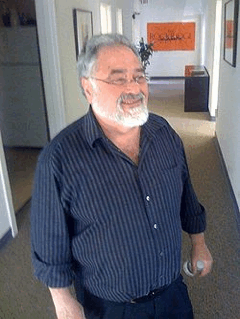
George Lakoff is a Democratic political strategist: (Photo by: Dave Winer)
CURWOOD: It’s Living on Earth, I’m Steve Curwood.
YOUNG: And I’m Jeff Young. If you’re interested in the climate change legislation currently on Capitol Hill, don’t try the phrase “climate change” in your text search, or “global warming”, you won’t find those words in the titles. The House-passed version is the American Clean Energy and Security Act, the Senate’s considering the Clean Energy Jobs and American Power Act.
CURWOOD: With the big UN climate change meeting coming in Copenhagen in December, Democratic leaders are eager to find the right words to sell their approach both at home and abroad. That’s the sort of word-smithing they often get from George Lakoff, the Berkeley linguist and the long time Democratic strategist. Professor Lakoff, please explain why democrats think they can pass a climate change bill when the words “climate change” are barely mentioned?
LAKOFF: Well, the easiest way to think about this is what the Pew Foundation found when it did its latest poll, which is that fewer people quote – believe - that climate change is real and caused by human beings, and as a result the administration has decided not to worry about that, not to take that on and have the debate over whether it’s real, but to just assume it’s real and go on.
CURWOOD: Okay, that Pew poll is just one poll though, so what else is really guiding this framing decision? You know, one of our producers here said, this discussion is being framed with an absent center; it’s like a donut we’re walking around here.
LAKOFF: That’s absolutely right, and you might ask another question: Why should the Pew poll result have come, why should fewer people believe in the reality of global warming and climate change? And the answer to that is that the conservative message machine has been going night and day on this while the Democrats have been talking about health care. So, the public, in at least independent and republican districts, have heard all over, over and over again, that you know, this isn’t real. So, they decided not to debate that and they’re just going to go ahead and play their cards, the cards that they think will get a bill passed.
CURWOOD: In your view, what are the odds that this bill is going to succeed? Some people would say, oh, we’re going to have to count it out now.
LAKOFF: I don’t see it succeeding before Copenhagen, and I think that’s part of the administration’s ideas. I think what they want is to go to Copenhagen with bipartisan support for something or other, and if they have something or other that they can claim is a victory, then they have some moral authority in Copenhagen.
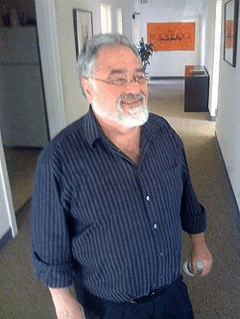
George Lakoff is a Democratic political strategist: (Photo by: Dave Winer)
CURWOOD: So, Mr. Obama walks into Copenhagen with perhaps, what? Some sort of agreement, some sort of committee passage of legislation, and the House has passed something. How do you frame that as progress enough to convince the international community that the US is really serious about dealing with climate change?
LAKOFF: You say, we are about to pass a bill, we have a slow democratic process, but it is happening. You pick out the parts of the bill that look the best and you put them forward, and you say, we’re going to do this, we’re going to pass the bill, we’re going to make it better over the years, and we want to work with you. Very simple. That’s what he’s going to say.
CURWOOD: And if President Obama were to choose not to go to Copenhagen, how could he frame that for the world and for America?
LAKOFF: I think he couldn’t. I don’t see it any possibility of his not going to Copenhagen, it just looks so bad both nationally, where he’s saying I can’t lead – he looks weak – and internationally, he looks weak.
CURWOOD: So, George Lakoff, you’re a linguist, you understand how we communicate with each other. What is it about the human condition that makes it so hard to talk about a slow moving, yet as science tells us, ultimately a deadly phenomenon known as climate disruption?
LAKOFF: Linguists have studied languages all over the world, and every language has a way to express causation, but that causation is always direct. It’s like, you know, I pick up this cup of coffee, that’s direct causation. Climate change isn’t like that. It happens all over the world, it’s a matter of a system – a system working because that is the central problem. People think in terms of a direct causation, the phenomenon is systemic causation.
CURWOOD: So, here’s a question: What language is better suited for communication systemic causation? Or is this part of the human condition?
LAKOFF: It’s part of the human condition. There’s no language better suited for speaking of systemic causation. They all have direct causation.
CURWOOD: And I suppose it is a human condition, right? I mean it’s very hard to link the extra item on one’s plate to something that appears around our waist, or handing over the credit card and the bill that will arrive later in the mail.
LAKOFF: You’ve got it, and moreover, the same problem is there the economy. You have short-term greed, and the assumption is that short-term greed is good. If everybody around the world is greedy in the short term then we’ll all be better off. We have the same problem in both the ecology and the economy. Short-term greed has created the problem over a very long time all over the earth, and we don’t have a comprehensive way of thinking about systemic risk and systemic causation.
CURWOOD: Democratic strategist George Lakoff teaches at the University of California, Berkeley. Thank you so much, George, for taking this time.
LAKOFF: It’s always a pleasure to be here.
Related link:
A Pew poll says that less Americans are convinced about the realities of global warming.
From Brownfields to Solar Plains
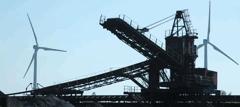
Turbines rise above the former Bethlehem Steel Mill in Lackawanna, N.Y. The federal government hopes to convert more abandoned industrial sites such as this to industrial-scale solar and wind facilities. (Photo courtesy First Wind.)
YOUNG: The country’s industrial wastelands could get new life as a source of clean energy. The EPA has identified thousands of old brownfields sites that might be developed for renewable energy, like wind, solar and geothermal. Soji Adelaja’s studied the sites in Michigan where he directs the Land Policy Institute at Michigan State University. Professor Adelaja, why look to brownfields for green energy?
ADELAJA: Well, some of our old industrial states, and indeed across the nation, have this huge inventory of brownfields that were used for manufacturing and different types of processing in the past. They had adequate connection to the grid, they had power infrastructure well in place, transportation wise they’re very well connected. So much of the infrastructure for this industrial activity to take place already surrounds these places. And the broader infrastructure, roads and so forth, to move the turbines in and move the solar panels in are already in place. On the other hand, there’s an opportunity with the renewed interest in the nation in renewable energy to apply renewable energy on some of these sites, create green jobs. So there’s some tremendous opportunities associated with brownfield sites.
YOUNG: So, these former industrial sites, these brownfield sites, they have a lot going for them, but do they have the energy? Do they have the wind; do they get the sun needed to make renewable energy happen?
ADELAJA: Indeed, that was the essence of our investigation in Michigan. We needed to understand where these brownfields were located and the sizes of those brownfields. So, what we did in our analysis was to look at the locations of these sites, measure the wind readings at those sites, also look at solar resource capacity at those sites, and then correlated those with the sizes of these parcels to be able to figure out just how much energy can be generated from these parcels. And we came up with numbers that actually surprised us. Michigan, for example, statewide could generate about 4,300 megawatts of power using coupled wind, solar array systems.
YOUNG: So, 4,300 megawatts that’s kind of like have the equivalent of a fleet of – I don’t know – eight or nine coal-fired power plants, isn’t it?
ADELAJA: Absolutely, and one other way to look at this is that in the case of Michigan we estimated that this is enough power to power about 40 to 45 percent of the homes in Michigan. So, we’re talking a substantive amount of energy and power being generated.
YOUNG: Now, are there places where this is already happening? Do you have examples of brownfields making green energy?

Turbines rise above the former Bethlehem Steel Mill in Lackawanna, N.Y. The federal government hopes to convert more abandoned industrial sites such as this to industrial-scale solar and wind facilities. (Photo courtesy First Wind.)
ADELAJA: Well, there are a couple that come to mind. In the case of wind energy, the old Bethlehem Steel Plant in Laquawanna, New York is now a wind farm. In the case of solar, there’s the old, former landfill in Fort Carson, Colorado. These are two examples.
YOUNG: And I understand that as popular as some forms of renewable energy are in the broad sense that there’s a bit of NIMBYism, not in my backyard, when it comes to actually putting a wind or other renewable energy facility somewhere. Do you have examples of that?
ADELAJA: Some of the communities are already dealing with a major challenge, visual blight, contamination, and so a windmill or a solar array right next door may not be as challenging for them as they would find a brownfield facility that’s underutilized. Windmills are not blight, by the way, I’ve traveled around the nation and looked at some of the solar farms and wind farms. I think they’re beautiful to behold, but there are people who have a challenge with it.
YOUNG: Now, often these old industrial sites, these are in lower income communities, communities of color. What’s in it for those neighborhoods, if these are redeveloped?
ADELAJA: Well, definitely green jobs and the potential to be employed in the building and development of these renewable energy facilities, that’s the first thing that comes to mind. But, secondly, because many of these sites are owned by the government in some of these communities, or the leadership in some of these communities. It’s a lot easier to structure opportunities to build an energy trust fund that proceeds from land leases and the sale of the land can then be put into say, economic development support funding in the community.
YOUNG: To hear you lay this out, it sounds like a no-brainer. Why haven’t we been doing this already?
ADELAJA: We were slow to realize the challenge that we face as a nation in securitizing our energy supply, and I think the nation has finally woken up. I have to say that national policy, while supportive, has never really been aggressive in support of renewable energy. I remember 30 years ago, the United States was one of the leaders in the world in renewable energy, and our national policies for a long time were not as aggressive as what the Europeans were doing. The Europeans are way ahead of us now, but there’s no doubt in my mind that we will eventually catch up. I think the goals that are being discussed in Congress with legislation that is being considered now are very aggressive. I think we’re thinking more appropriately about sustainability and carbon footprint now and so that favors renewable energy.
YOUNG: Soji Adelaja directs the Land Policy Institute for Michigan State University. Thank you, sir.
ADELAJA: Thank you.
Related links:
- Link to Land Policy Institute brownfields report in association with Rutgers:
- Link to attached PHOTO of wind mills at the Bethlehem Steel Mill in Lackawanna, N.Y.
[MUSIC: Ernest Ranglin “Ragga Style” from ‘Grooving’ (One Media Publishing - 2007)]
Perfect Storm for Fish Kill
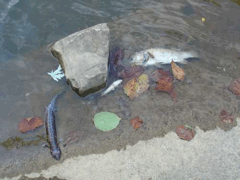
Dead fish and a salamander float close to shore in Dunkard Creek, days after a massive fish kill destroyed the ecosystem. (Photo: Ben Adduchio/West Virginia Public Broadcasting)
YOUNG: Dunkard Creek. Along the Pennsylvania/West Virginia border once drew crowds of fisherman and boaters until September, when almost all the aquatic creatures living in the creek died. Regulators blame the fish kill on a bloom of toxic golden algae fueled by pollution from nearby coalmines and gas drilling sites. This is the first time they’ve documented the invasive golden algae in the region. And, as Erica Peterson of West Virginia Public Broadcasting reports, the same pollution that fed the bloom in Dunkard Creek could help the algae spread across the Mid-Atlantic.
[WATER RUNNING]
PETERSON: Until recently, Dunkard Creek was teeming with life – with more than 160 species of fish, mussels, salamanders and crayfish. But in September, a massive fish kill eliminated nearly every living thing in this creek, which winds 38 miles back and forth across the Mason-Dixon Line.
[INSECT SOUNDS; MOVING WATER; GRAHAM SAYING “FRESH WATER’S COMING IN…]
PETERSON: Jesse Graham walks along the banks of Dunkard Creek the morning after the fish kill in mid-September. Dead fish line the banks. Buzzards circle overhead.
GRAHAM: Have you ever been around the ocean where they’re doing crabs and so on and they’re old and decaying? That’s what it smells like.
PETERSON: Graham has lived on the banks of Dunkard Creek since 1970, and says it’s always seemed to be a healthy stream, until now.
GRAHAM: I had a deer come up the driveway, I think looking for water, because I’ve never had a deer come up the driveway like that. They probably were used to drinking in the Dunkard and they knew it wasn’t fit to drink and they were looking.
PETERSON: Now, Dunkard Creek is a rusty color and regulators in West Virginia say golden algae killed the ecosystem. Golden algae have been found in Southern and Southwestern states, and are typically found in freshwater areas with a high salt content. Officials don’t know how the invasive algae got into Dunkard Creek, but believe it flourished because of massive amounts of salty pollution from coalmines and gas drilling. Randy Huffman is the head of the West Virginia Department of Environmental Protection. He says a lot of different factors contributed to the toxic bloom.
HUFFMAN: The algae is the culprit, but the water temperature, the sunlight, and the makeup of the water from the mine drainages, we think, have worked together to create the perfect storm for this algae.
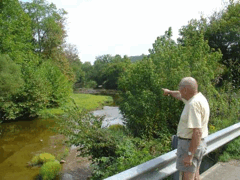
Jesse Graham points to the spot on Dunkard Creek where he first noticed dead fish. Graham has lived near Dunkard Creek since 1970 and never knew the creek was so polluted. (Photo: Ben Adduchio/West Virginia Public Broadcasting.)
PETERSON: This “perfect storm” was partly made possible by negligence—on the part of Huffman’s agency, as well as others. The pollution can be traced back to mining company Consol Energy. Consol is the nation’s fifth largest coal producer, and contributes more than 500 million dollars a year to West Virginia’s economy. It operates in five other states. For years, Consol has been releasing chloride and other pollutants into Dunkard Creek from two separate mines. And the West Virginia Department of Environmental Protection let them. Starting in 2002, the DEP issued three orders allowing Consol to violate the federal Clean Water Act as it looked for a way to control the pollution. While at a talk on business ethics, Consol spokesman Joe Cerenzia says his company’s discharge was harmless until the algae were added into the mix.
CERENZIA: For the past however many years, the fish were fine and all of the aquatic life in Dunkard Creek were surviving just fine. It’s this additional element that was put in there that has changed the dynamics of that whole situation.
PETERSON: The situation was complicated by the fact that Dunkard Creek crosses state lines, with two states and the federal Environmental Protection Agency overseeing pollution. Currently, Consol has a permit from the EPA to dispose of salty wastewater from a Pennsylvania gas drilling operation into one of the West Virginia mines that discharge into Dunkard Creek. The EPA ordered Consol to stop injections last month.
[WALKING ON DIRT PATH]
PETERSON: The residents who live along Dunkard Creek had no idea how polluted it was becoming – until it was too late.
WILEY: Dunkard Creek is a member of the family.
PETERSON: Betty Wiley is the president of the Dunkard Creek Watershed Association, a local non-profit that promotes the importance of the watershed.

Dead fish and a salamander float close to shore in Dunkard Creek, days after a massive fish kill destroyed the ecosystem.
(Photo: Ben Adduchio/West Virginia Public Broadcasting)
WILEY: It’s grief, it’s real grief, like a member of the family died, only you can’t bury this one. It’s still there, and you have to do something about it. Try to bring it back to life.
PETERSON: In a park along the Mason-Dixon Line, Wiley looks at old photographs of the creek. One shows her father smoking a pipe and holding his day’s fishing catch: seven fish. Now, Wiley worries other streams across the country could suffer the same fate.
WILEY: I think it’s national in scope. It’s a huge environmental disaster, really. When did you ever know of a 38-mile long ecosystem being just totally being wiped out? Totally, everything’s dead.
PETERSON: The factors that made Dunkard Creek an ideal golden algae habitat, like large amounts of chlorides and other pollutants, are replicated throughout the state and the region.
[MANDIROLA SAYING “NOW THAT WE KNOW ITS GOLDEN ALGAE THAT;S ACTUALLY DOING THE KILLING OF THE FISH, WE NEED TO FIGURE OUT WHY…]
PETERSON: Scott Mandirola oversees water programs with the West Virginia DEP. In a presentation about the fish kill to state legislators, he points to a list of 20 other streams and rivers ripe for algae blooms. Now that golden algae has made its way north, he says it’s possible it could invade other similar watersheds in other states, like the north branch of the Potomac River in Maryland and West Virginia.
MANDIROLA: We don’t know exactly how the algae got here, we don’t know if it’s been here for a while or if it just came in the last year or so. Our concern is, because we’re not clear on how it transports, if it does transport to another ecosystem that has a conducive environment, we could see a similar bloom.
PETERSON: Once it’s in a waterway, golden algae are nearly impossible to eliminate. In West Virginia, the DEP now wants to lower the pollution levels in these streams to make them more hospitable to green algae—which isn’t toxic, and could prevent the spread of its golden cousin. But first, state and federal regulators have to do something they haven’t so far -- put tighter pollution controls in place, and enforce them. For Living on Earth, I’m Erica Peterson in Charleston, West Virginia.
Related links:
- Dunkard Creek Watershed Association
- West Virginia DEP – info on Dunkard Creek water quality
- West Virginia Public Broadcasting coverage of the Dunkard Creek fishkill
- Information about “compliance orders” which give polluters extra time to comply with environmental laws.
[MUSIC: Club D’Elf “The Tingler” from ‘Perhapsody Live 10-12-06’ (Kufala Records - 2007)]
CURWOOD: Coming up – new rules for energy-guzzling TV’s in the Golden State. Don’t touch that dial – stay with us on Living on Earth.
ANNOUNCER: Support for the environmental health desk at Living On Earth comes from the Cedar Tree Foundation. Support also comes from the Richard and Rhoda Goldman fund for coverage of population and the environment. And from Gilman Ordway for coverage of conservation and environmental change. This is Living On Earth on PRI, Public Radio International.
New TV Rules in the Golden State

Flat screen TVs are some of the most energy intensive appliances in the home.
YOUNG: It's Living on Earth, I'm Jeff Young.
CURWOOD: And I’m Steve Curwood. So do you know what single appliance in your home uses the most electricity? If you said the refrigerator you’d be right - thirty years ago. But today – beyond temperature control and lighting – your big flat-screen TV could be the most energy thirsty appliance. Now the California Energy Commission plans to put televisions on an energy diet, with new TV efficiency standards, similar to those set for refrigerators three decades ago. The California commission could vote on the proposed regulations as early as Nov 4th. Marc Lifsher from the Los Angeles Times joins us to explain what’s on the table. Hello there, Marc!
LIFSHER: Hello.
CURWOOD: So, what will these new proposed rules say?
LIFSHER: They’ll set definite standards for electricity consumption for televisions, and that would include the LCDs, the old standard cathode-ray tubes – if they’re still around – and plasma TV’s and rear-projection TV’s. The standards will kick in in 2011 and then will become more stringent in 2013. For now, it will only affect TV’s 58 inches and smaller.
CURWOOD: Now, what’s different about this from, say, the Energy Star program?
LIFSHER: The Energy Star program is a federal program, it’s a voluntary and it’s a mean of informing consumers through large tags and information showing what are the most energy-efficient products of that type available in the store. California’s rules, when they’re passed, will be mandatory, and no TV that doesn’t comply will be able to be sold after the dates that it goes into effect.
CURWOOD: So, why is California making this rule now?
LIFSHER: California, after studying this issue for a couple of years, came to the conclusion that the television and the related equipment like TiVos and DVD players now account for about ten percent of household electrical use. And, that’s up from two to three percent from just a decade ago, and it’s a very, very fast-growing segment, and they figure they can limit it now before it gets larger.
CURWOOD: So what kind of savings are we talking about, in terms of energy, and in terms of money?
LIFSHER: The commission estimates that the savings will be $912 million in the first year. It will be about $30 per television set. And they estimate that it will save eight point one billion over the first ten years, and it will eliminate the need to spend about 650 million to build at least one large, gas-fired power plant.
CURWOOD: And, Marc, if I walked into a TV store today, how many of those being sold would meet the likely California standards?

Flat screen TVs are some of the most energy intensive appliances in the home.
LIFSHER: The manufacturers say there are already scores of TVs that do meet the standards for 2011, and even some that meet them for 2013, which is more stringent. And the manufacturers including industry leader, Visio of Irvine, California; they say they’ll have no problem meeting or exceeding the standards at the dates that they kick in. Some other manufacturers are a bit more skittish; they in general don’t like the idea of regulations. They’d rather just do it on their own and let innovation take its course – they argue that the efficiency will come no matter what – you don’t need government rules.
CURWOOD: So, what’s in this for consumers?
LIFSHER: Well, they’ll save on their electric bills every month, and they’ll get a TV that’s just as good in quality as the ones now, and maybe better with the natural innovation that’s going on. And, other than that, it shouldn’t affect them at all.
CURWOOD: So, if California has this standard, what about folks going to nearby states? The drive over to Nevada to get a TV that doesn’t have these restrictions might be a bit cheaper. Would jobs be lost? What about the sale tax revenue for the state?
LIFSHER: It’s conceivable that some people living near the boarders with our neighbors will go and buy TV’s that might not be compliant with California, and there could be some loss of sales tax, but it’s unlikely that people are going to travel far. Nevada is pretty far away from the population centers of California.
CURWOOD: Now, what will this do to the price of televisions?
LIFSHER: The LCD – the Liquid Crystal Display Television Manufacturers Association – has said in a letter to the commission that they don’t expect it to affect price at all. And, indeed, prices have been coming down over the years, and that may continue.
CURWOOD: California is what – the eighth or so – largest economy in the world, and when you’re that big you can kind of throw your weight around in the regulatory arena. What do these new standards effectively mean for the rest of us who don’t live in California?
LIFSHER: California has a long history of imposing efficiency standards on appliances, whether they’re air conditioners or refrigerators, insulation for your house, they’re soon to do it on cars. And those have quickly spread to other states who virtually picked up the California laws and passed them almost word for word. Manufacturers are not going to want to make different kinds of TV’s for different parts of the US market. Eventually, they’ll all be the same, and they’ll all meet California and other states’ – presumably – standards.
CURWOOD: So this is yet another example of California being upfront when it comes to energy efficiency?
LIFSHER: Uh, yes, and California has a good record. Over the last 30 years, per capita electricity usage has been flat here because of these efficiency standards, while it’s gone up 40 to 50 percent in the rest of the country. So, California, obviously, is getting a lot out of every electron.
CURWOOD: In other words, a megawatt saved is a megawatt earned?
LIFSHER: A megawatt saved is a megawatt you don’t have to create greenhouse gas and pollution to produce and spend a lot of money producing.
CURWOOD: Marc Lifsher writes for the Los Angeles Times. Thank you so much, sir.
LIFSHER: You’re welcome.
Related link:
California Energy Commission
[MUSIC: Dinah Washington “TV is the Thing This Year” from ‘Greatest Hits 1946 – 1953’ (Orchard Records - 2004)]
Dining with Birds
CURWOOD: On the second of October, the worlds of birding – and giant vegetables – lost a champion. Hugh Wiberg was renowned in New England for his prowess in nurturing mighty pumpkins – and his devotion to birds. His stillness and persistence won him a rare skill – and he wrote a book about it – “Hand-Feeding Backyard Birds”. In the year 2000, I visited the Ipswich River Wildlife Sanctuary with him to find out how he won the trust of his flighty friends. Here’s a portion of our story from back then – with bird-lover Hugh Wiberg.
WIBERG: Human beings have been conditioned since early childhood to believe that wild birds are going to stay clear of human beings. And for the most part that's true. But what I've discovered by wandering through various wildlife sanctuaries in Massachusetts is that if you have a lot of patience, and can take the time, you can condition the birds to take feed right out of your hand.
CURWOOD: So they get to know you. You become their buddies.
WIBERG: Exactly. You become their buddies.
CURWOOD: Okay, well what are we going to do now? Tell me what -
WIBERG: All right. We're going to take a walk down into an area in this sanctuary where the birds have pretty much come to expect that when Wiberg walks into the sanctuary they're going to get a free snack. And I've found, doing a lot of experimenting, that the wild birds, particularly the common birds that we see in this area, the nuthatches and the chickadees and the tufted titmice, they love walnut meats. And I'm holding in my hand right now lots of little bits of walnut meat. And with any luck at all, we're going to have some company this morning as we wander down into the sanctuary.
CURWOOD: Okay, well let's go.
[FOOTSTEPS WALKING ON PATH; CRUNCHING GRASS AND LEAF SOUNDS]
WIBERG: Now, we're coming into an area of pine trees here, where I usually am greeted by a small group of chickadees who are looking for their morning handout.
CURWOOD: Will they be scared by us talking?
WIBERG: They will not be scared if we talk while they're around. Their hearing mechanisms are decidedly different than ours. I think they're on a much higher frequency than we are. I'm not at all sure that they even hear us when we talk. Now, let's stand here for just a minute and see if any of these guys are aware of my presence yet. I'll be very embarrassed if they're a half a mile from here, but we'll see chickadees. Maybe not right in this spot, but we will see them. Good morning gentlemen, ladies. Anybody looking for a snack here today?
[BIRD LIGHTLY CHIRPING IN DISTANCE]
WIBERG: Dead silence. (Laughs) That's the sound of a black cat chickadee that you just heard. All right, these guys are chattering to themselves about something else, so we're going to continue our little walk a little further down here. And we will encounter some chickadees as we walk down this path over here.
[FOOTFALLS ON GROUND]
CURWOOD: How often do you come?
WIBERG: In the wintertime, at least once a week, usually on a Saturday or a Sunday morning. Here we go.
[A LOUD CHIRP; WINGS FLAPPING]
CURWOOD: Well, look at that. There comes one, and now another one.
WIBERG: You see, we've got quite a little family in here that are -- they have their own pecking order. They're lining up, up there, to come in, depending on where they stand in the chickadee hierarchy.
CURWOOD: This one is next, kind of a big one. This is amazing.
WIBERG: Isn't that fun?
[A LOUD CHIRP]
WIBERG: Now, Steve, for just a second here I'm going to put some feed in your hand, and you're going to have one or two of these guys on you before you can say Jack Robinson. Stand right up there, close to that shrub. See now, they're a little cautious, because you're a stranger to them. But you're with me, and they know me. And there's a tufted titmouse up there, by the way.
CURWOOD: Oh there comes one.
WIBERG: You almost had that titmouse standing on your hand.
CURWOOD: He chickened out after --
WIBERG: He'll be back.
CURWOOD: Well there's a -- (Laughs) Oh, that's amazing!
WIBERG: And the first one is always the biggest thrill. I'd like to see that titmouse come down and stand there.
CURWOOD: Oh, here's another chickadee. And another one.
[MULTIPLE LOUD CHIRPS; SWIFT, FLAPPING WINGS]
CURWOOD: Does it hurt the birds to feed them like this?
WIBERG: Hurt in what sense?
CURWOOD: What if they become dependent?
WIBERG: Okay, that's a very good question. The School of Ornithology at Cornell University did a controlled test on exactly that question. They had two groups of chickadees out in the field, one who were deep in the forest who had never had any contact with human beings, and another that were close to society and were getting bird food on a regular basis. And the birds that were being fed on a regular basis had their food cut off after six months, the warm summer months. Anyway, the long story short was that both groups of birds showed no drop off in mortality rates, whether they had contact with humans or whether they did not. So the consensus appears to be that this does not hurt them in any way.
CURWOOD: Whatever got you started hand-feeding birds?
WIBERG: Well, I think what probably attracted my attention in the beginning was, I'd been feeding birds with my bird feeders back in Wilmington, Mass. for 25 years. And I noticed early on that the chickadees were the very last bird to fly away when I went out to restock the feeders. So I had, once in a great while I'd seen a picture of a black-capped chickadee standing on a human hand. And I decided one day to see, where the birds in my back yard seemed to be quite accustomed to my presence, to see if I could actually get one of them on my hand. So I set up a stepladder in the back yard, took the feeder down, put it in the house, and became in effect a substitute bird feeder. And after three or four weekends of trying this, in January I think it was, a chickadee came down and stood on my hand and took some seed. And his fellow travelers saw what was happening, and eventually many of them began to hand-feed also.
CURWOOD: Hugh, before we go --
WIBERG: Sure.
CURWOOD: I just have to ask you about your other life.
WIBERG: Okay, and believe me, I do have another life.
CURWOOD: You grow giant pumpkins?
WIBERG: Yes I do. I am the director of an esoteric organization here in New England called the New England Pumpkin Growers Association, with over 500 members. We dedicate ourselves in a lighthearted manner to the fine sport hobby of growing these monster, giant pumpkins that you see at the fairs every fall. My personal best pumpkin, largest pumpkin, was a 674-pounder that I grew two years ago, that came in fifth in the All-New England fair. That year there was a 920-pounder grown that came in first place.
CURWOOD: Hugh Wiberg speaking with me in the year 2000. The day after he died, a pumpkin weighing one thousand, four hundred and seventy one point six pounds (1,471.6lbs) won the top prize at America’s oldest agricultural fair, in Topsfield, Massachusetts.
[MUSIC: Anouar Brahem “The Astounding Eyes Of Rita” from ‘The Astounding Eyes Of Rita’ (ECM Records - 2009)]
Still Life
KLINKENBORG: Every now and then I feel as though I’ve woken up in a Rembrandt etching – a low, tangled thicket of pen-strokes from which a landscape emerges.
YOUNG: Commentator Verlyn Klinkenborg.
KLINKENBORG: It’s not so much that the sky has taken on the tint of 17th-century drawing paper or that the world has lost its color. It has more to do with the balance of time. I wake up and nature seems to have paused in expectation. There is a numb overcast overhead, with little drift to it. Wood smoke slides down the roof and onto the road. The wild apples are waiting to fall. We are all inked in, caught in the moment. It’s an appealing illusion. I imagine being the human in one of Rembrandt’s landscapes -- that small figure standing in front of what looks like a cross between a house and a haystack. He is resting from something. Perhaps he’s even looking out from his garden at the artist working in the distance. It took no more ink to draw that figure than it would to write out a simple equation.
And yet there’s no mistaking his posture or the moment he’s given himself to rest, though that moment has now lasted since 1645. That’s how it felt this morning -- as if time had simply stopped. A crow had paused in the pasture. I counted fifteen mourning doves resting on a power line. The leaves that were going to fall had fallen, and the oaks were not about to relinquish theirs. The weather seemed to be waiting somewhere off to the west. A flight of birds stirred from the branches and then settled back almost immediately. I heard what sounded like a small dog barking in the distance and realized it was a flock of geese beyond the tree line. They never came into view.
Before long the breeze will stir, and rain will begin to fall. The silent anticipation hidden in such a quiet morning will be forgotten. The cry of a red-tailed hawk will unsettle the mourning doves, and one by one those wild apples will become windfall. And as the weather changes and the clock resumes its ticking, I’ll have to free myself from the artist’s ink before it dries completely, step outside and walk over the hill toward the sound of those distant geese.
YOUNG: Verlyn Klinkenborg lives on a small farm in New York state. He writes editorials for the New York Times.
[MUSIC: Tommy Flanagan/Hank Jones “ Autumn Leaves” from ‘Our Delights’ (Fantasy Records - 1978)]
YOUNG: On the next Living On Earth – Twenty years later, a Cold War no man’s land is flourishing.
GRICHTING: This space used to be totally barren sand with weed killers and now nature has reclaimed this space and what their experiment is to cooperate with nature.
YOUNG: Where the Berlin Wall once stood, there’s now life, art and music – thanks to squatters. That’s next time on Living on Earth.
YOUNG: Living on Earth is produced by the World Media Foundation. Our crew includes Bobby Bascomb, Eileen Bolinsky, Bruce Gellerman, Ingrid Lobet, Jessie Martin, Helen Palmer, Jessica Ilyse Smith, Ike Sriskanderajah, and Mitra Taj, with help from Sarah Calkins, Marilyn Govoni and Sammy Souza. Thanks this week to WGCU public media in Fort Myers, Florida.
CURWOOD: Our interns are Quincy Campbell and Nirja Parekh. Jeff Turton is our technical director. Alison Lirish Dean composed our themes. You can find us anytime at LOE dot org. I’m Steve Curwood.
YOUNG: And I’m Jeff Young. Thanks for listening!
ANNOUNCER 1: Funding for Living On Earth comes from the National Science Foundation supporting coverage of emerging science. And Stonyfield farm, organic yogurt and smoothies. Stonyfield pays its farmers not to use artificial growth hormones on their cows. Details at Stonyfield dot com. Support also comes from you, our listeners. The Ford Foundation, The Town Creek Foundation, The Oak Foundation—supporting coverage of climate change and marine issues. The Rockefeller Foundation and its campaign for American workers. More at rockfound dot org. And Pax World Mutual Funds, socially and environmentally sustainable investing. Pax world for tomorrow. On the web at pax world dot com.
ANNOUNCER 2: PRI – Public Radio International.
Living on Earth wants to hear from you!
Living on Earth
62 Calef Highway, Suite 212
Lee, NH 03861
Telephone: 617-287-4121
E-mail: comments@loe.org
Newsletter [Click here]
Donate to Living on Earth!
Living on Earth is an independent media program and relies entirely on contributions from listeners and institutions supporting public service. Please donate now to preserve an independent environmental voice.
NewsletterLiving on Earth offers a weekly delivery of the show's rundown to your mailbox. Sign up for our newsletter today!
 Sailors For The Sea: Be the change you want to sea.
Sailors For The Sea: Be the change you want to sea.
 The Grantham Foundation for the Protection of the Environment: Committed to protecting and improving the health of the global environment.
The Grantham Foundation for the Protection of the Environment: Committed to protecting and improving the health of the global environment.
 Contribute to Living on Earth and receive, as our gift to you, an archival print of one of Mark Seth Lender's extraordinary wildlife photographs. Follow the link to see Mark's current collection of photographs.
Contribute to Living on Earth and receive, as our gift to you, an archival print of one of Mark Seth Lender's extraordinary wildlife photographs. Follow the link to see Mark's current collection of photographs.
 Buy a signed copy of Mark Seth Lender's book Smeagull the Seagull & support Living on Earth
Buy a signed copy of Mark Seth Lender's book Smeagull the Seagull & support Living on Earth

